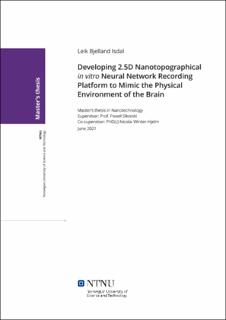Developing 2.5D Nanotopographical in vitro Neural Network Recording Platform to Mimic the Physical Environment of the Brain
Master thesis
Permanent lenke
https://hdl.handle.net/11250/2788877Utgivelsesdato
2021Metadata
Vis full innførselSamlinger
- Institutt for fysikk [2695]
Sammendrag
På tross av sin vanvittige kompleksitet er nervesystemet en del av menneskets anatomisom er spesielt sårbar. Nevrodegenerative sykdommer som Alzheimers og Parkinsonsforårsaker omfattende og uopprettelig skade hos de som blir rammet, og utover de emosjonelle kostnadene for individ og familier pålegger det også samfunnetstore økonomiske kostnader. Nye sykdomsmodellsystemer trengs sårt i utviklingen avbedre behandling og mer effektiv diagnostisering av nevrodegenerative sykdommer.De siste årene har fremskritt innen mikrofabrikasjon og stamcelle-teknologier gittgrobunn for kraftige in vitro-modellsystemer av det menneskelige nervesystemet ogdets patologier. Ved å dyrke nevroner i mikrofluidiske kammer spedd med mikroelektroderkan vekst av nevrale nettverk utføres innenfor kontrollerte rammer, mensmålt nettverksaktivitet gir indikasjon på nettverkets tilstand av funksjon eller dysfunksjon.Avgjørende for den kliniske relevansen til slike modellsystemer er deres evne tilå gjenskape nervesystemets småverksnettverksarkitektur – arkitektur som muliggjørkomplekse tanker, men også rask spredning av sykdom. Tradisjonelt har in vitro nevralenettverks-systemer vært basert på plane substrater, og neglisjert den viktige rollenhjernens fysiske mikro- og nanoskala-miljø spiller i å lede nettverksorganisasjon.Resultatet har vært nettverksarkitektur som har fraveket de viktige småverdensprinsippenei nervesystemet.I et forsøk på å forbedre nettverksarkitektur, og derav klinisk relevans, satt detteprosjektet som mål å utvikle en ny in vitro nevral nettverksplattform med nanotopografiersom etterligner hjernens nanoskala fysiske miljø. En plasmaetsingsbasertruprosess for nanotopografisk strukturering av SU-8-resist ble etablert, og viste utmerketevne til å oppnå en rekke forskjellige nanotopografier ved modifisering av etseparametre.Nanotopografisk SU-8 ble videre vist å kunne erstatte det tidligere brukte planeSi3N4-basesubstratet på nevrale nettverksplattformer. Her ble det vist å være kompatibeltmed binding av mikrofluidstrukturer, og som isolasjon for elektrodeponering avplatinum sort-elektroder og under målinger av nevral nettverksaktivitet. Et avgjørendefunn var at nanotopografier kan fremme klynging av nevroner og aksonfascikulasjon,samt lavere grad av global synkronisering i nettverksaktivitet - karakteristiske strukturelleog funksjonelle trekk for småverdensnettverk. Samtidig som det er behov forytterligere optimalisering og eksperimenter med større utvalgstørrelser før endeligekonklusjoner kan trekkes, viste den utviklede nanotopografiske plattformen såledespotensiale for å forbedre kliniske relevans av in vitro nevrale sykdomsmodellsystem. Despite its incredible complexity, the nervous system is a part of the human anatomythat is particularly vulnerable. Neurodegenerative diseases such as Alzheimer’s andParkinson’s disease wreak havoc on this vulnerable system, causing irreparable and extensivedamage to the ones affected, and casting heavy economical burdens on society.In pursuit of greater insight into detection and treatment of such neurodegenerativediseases in early onset, novel disease model systems are in dire need.In recent years, advancements within microfabrication and stem cell technologieshave given rise to powerful in vitro model systems of the human nervous system andits pathologies. By culturing neurons in microfluidic compartments embedded withmicroelectrode arrays, growth of neural networks can be carried out in controlled environmentsand network activity recorded and analysed to determine state of functionor dysfunction. Critical to the clinical relevance of such model systems is their abilityto recapitulate the small-world network architecture of the nervous system – anarchitecture enabling complex thought but also rapid disease spread. Traditional invitro neural network systems have been based on planar substrates, neglecting theimportant role of the physical micro- and nanoscale environment of the brain in guidingnetwork organization. Consequently, grown networks have exhibited architecturediverging from the important small-world principles of the nervous system.In an effort to improve network architecture and, by extension, clinical relevance,this project set out to develop a novel in vitro neural network recording platform withnanotopographies mimicking the physical environment of the brain at the nanoscale.A plasma etch based roughening process for nanotopographical structuring of SU-8resist was established, demonstrating excellent flexibility in achieving a range of nanotopographiesby tuning of etching parameters. Nanotopographical SU-8 was furtherdemonstrated to be a viable direct replacement for the previously used planar Si3N4base substrate on neural network recording platforms. Herein, it was proved compatiblewith bonding of microfluidic structures, and as insulation for electrodepositionof platinum black electrodes and during neural network recording. Crucially, nanotopographieswere found to promote clustering of neurons and axon fasciculation, aswell as lower synchrony in global network activity – characteristic structural and functionalfeatures of small-world networks. While further optimization and investigationwith larger sample sizes are needed before definitive conclusions can be drawn, the developednanotopographical platform have, in conclusion, shown promise in improvingclinical potential of in vitro neural disease model systems.
